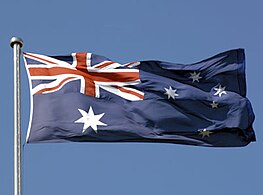Australian nationalism

| This article is part of a series on the |
| Politics of Australia |
|---|
 |
| Constitution |
| The Crown
|
| Executive
|
| Legislature
|
| Judiciary |
| States and territories
|
| Foreign relations |
| Ideology |
 Australia portal Australia portal
|
|
| Part of a series on |
| Nationalism |
|---|
| Core values |
|
| Organizations |
| Related concepts
|
|
|
| This article is part of a series on the |
| Eureka Rebellion |
|---|
   Eureka Stockade Riot by John Black Henderson, 1854 |
| The Eureka Rebellion
|
| Legacy
|
 Australia portal Australia portal |
|
Australian nationalism is the ideology, movement and sentiment that emphasizes the identity, culture, and interests of Australia as a nation-state, asserting the identity of Australians as a distinct nation.[1] It encompasses a range of beliefs and values that are often rooted in Australia's history, geography, and socio-political context.[2] Key elements of Australian nationalism include a sense of national pride, attachment to Australian symbols such as the flag and national anthem, and a focus on promoting Australia's sovereignty and independence.[3]
Historically, Australian nationalism emerged during the late 19th and early 20th centuries as Australia moved towards federation and gained independence from British colonial rule,[1][4] developing itself in three pivotal historical traditions: the labour movement, the republican movement and the native-nationalist movement.[5] It was shaped by factors such as the experiences of early settlers and the desire for a distinct Australian identity separate from British influence.[1][6]
History
Pre-Federation
By the early 19th century, Australia was governed as a series of six largely self-governing colonies that were spread across the continent and were part of the British Empire.[7] Attempts to coordinate governance had failed in the 1860s due to a lack of popular support and lack of interest from the British government, but by the 1880s, and with the rise of nationalist movements in Europe, the efforts to establish a federation of the Australian colonies began to gather momentum. The British government supported federation as a means to cement British influence in the South Pacific.[8]
Post-Federation
Nationalistic sentiments increased as a result of Australia's participation in the First and Second World Wars, with concepts such as "mateship" becoming a cornerstone of Australian nationalism.[9]
Australian nationalist parties
Current
- Liberal Party of Australia (National Right Faction)
- Australia First Party
- Australian Protectionist Party
- Katter's Australian Party
- Pauline Hanson's One Nation
- The Great Australian Party
Defunct
- Advance Australia Party
- Australian Nationalist Party
- Centre Party
- Fraser Anning's Conservative National Party
- Love Australia or Leave
- Nationalist Party
- Reclaim Australia: Reduce Immigration
- Rise Up Australia Party
Australian nationalist movements and groups
Active
- National Socialist Network
- Antipodean Resistance
- Australian League of Rights
- True Blue Crew
- Lads Society
Defunct
Prominent Australian Nationalists
Historical
- Frank Anstey
- William Baylebridge
- Ben Chifley
- John Gorton
- Rex Ingamells
- William Lane
- Jack Lang
- John Dunmore Lang
- Henry Lawson
- Norman Lindsay
- Alexander Rud Mills
- John Monash
- Ian Mudie
- Banjo Patterson
- Percy Stephenson
- William Wentworth
- Gough Whitlam
Contemporary
See also
- Australian patriotism
- Culture of Australia
- Anzac spirit
- Reclaiming Patriotism
- Federation of Australia
- Foreign relations of Australia
Flags
Flags used by Australian Nationalists
-

-
 Older variations of the Australian flag
Older variations of the Australian flag -

-

-
 "The Men From Snowy River" flag used during World War I snowball marches
"The Men From Snowy River" flag used during World War I snowball marches
References
- ^ a b c "Nationalism in Australia". Archived from the original on 1 September 2016. Retrieved 11 March 2016.
- ^ "Surrendering nationalism". Griffith Review. Retrieved 11 March 2016.
- ^ Christopher Scanlon (25 January 2014). "Australia Day: is nationalism really so bad?". The Conversation. Retrieved 11 March 2016.
- ^ John Bradley Hirst (2009). Sense and Nonsense in Australian History. Black Inc. ISBN 9781921825408.
- ^ Pascale, Carmela (2022). History, Territory and Sovereignty: Celebrating Settler Nationalism in South Australia, 1900–1968 (PhD thesis). The University of Adelaide. Retrieved 5 May 2024.
- ^ Crisp, Leslie (1949). The Parliamentary Government of the Commonwealth of Australia. Adelaide: Longmans, Green & Co. Lotd. pp. 2.
- ^ Trainor, Luke (1 January 1994). British Imperialism and Australian Nationalism: Manipulation, Conflict and Compromise in the Late Nineteenth Century. Cambridge University Press. pp. 3–4. ISBN 9780521436045.
- ^ Trainor, Luke (1 January 1994). British Imperialism and Australian Nationalism: Manipulation, Conflict and Compromise in the Late Nineteenth Century. Cambridge University Press. p. 4. ISBN 9780521436045.


























